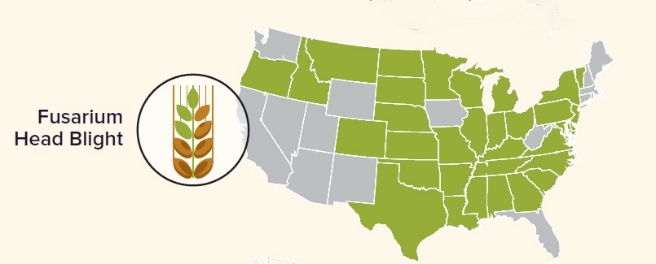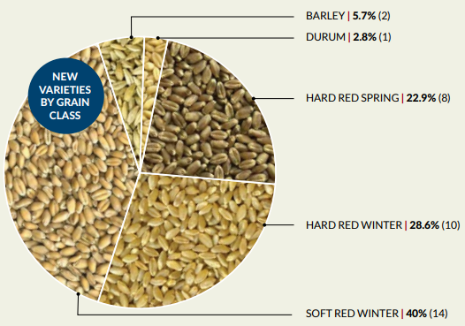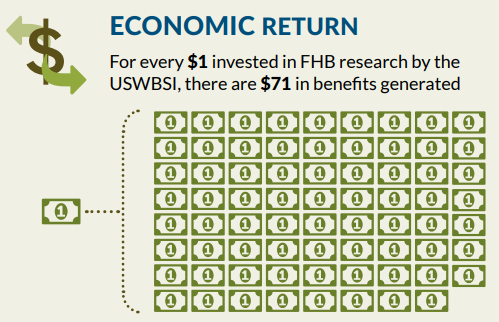About the USWBSI
The USWBSI is a national multi-disciplinary and multi-institutional research consortium whose goal is to
develop effective control measures that minimize the threat of Fusarium Head Blight (scab),
including the production of mycotoxins, for producers, processors and consumers of wheat and barley.
The USWBSI’s annual budget comes from Federal funds appropriated through the USDA-ARS and is
distributed to 150 research projects in more than 30 states.
Current Action Plan
Historic Listing of USWBSI Action Plan Development
Overview of the
U.S. Wheat and Barley Scab Initiative
 Fusarium Head Blight (FHB or scab) has emerged as one of the most significant plant diseases to threaten American agriculture. This disease, also known as “scab,” impacts cereals, particularly wheat and barley, reducing crop yield and quality with outbreaks reported in more than 30 states. Food industries throughout the U.S. incur losses from the cost of dealing with the toxin-contaminated grain that often accompanies scab infection. Combined losses to all steps in the food system are difficult to estimate, but with the U.S. average annual farm-gate value for wheat and barley at nearly $15 billion, minimizing losses of these two crops is critical. FHB-related losses to farmers, food processors, and brewers is estimated to run in the hundreds of millions of dollars annually. The U.S. Wheat & Barley Scab Initiative’s (USWBSI) stakeholder-driven approach to research on this devastating disease is aimed at identifying and providing research-based solutions to mitigate the problem of FHB in wheat and barley.
Fusarium Head Blight (FHB or scab) has emerged as one of the most significant plant diseases to threaten American agriculture. This disease, also known as “scab,” impacts cereals, particularly wheat and barley, reducing crop yield and quality with outbreaks reported in more than 30 states. Food industries throughout the U.S. incur losses from the cost of dealing with the toxin-contaminated grain that often accompanies scab infection. Combined losses to all steps in the food system are difficult to estimate, but with the U.S. average annual farm-gate value for wheat and barley at nearly $15 billion, minimizing losses of these two crops is critical. FHB-related losses to farmers, food processors, and brewers is estimated to run in the hundreds of millions of dollars annually. The U.S. Wheat & Barley Scab Initiative’s (USWBSI) stakeholder-driven approach to research on this devastating disease is aimed at identifying and providing research-based solutions to mitigate the problem of FHB in wheat and barley.
When scab was first recognized as an emerging disease of significant economic concern, the existing private, state, and federal research systems in the U.S generally handled research efforts on newly emerging pests and diseases. Scab presented unusual challenges at the time which warranted a new approach to research. Reasons why the disease fell in this category included:
- Scab is an economic threat to growers, processors and consumers of wheat of all grain classes and barley throughout much of the cereal production region of the U.S.
- Research expertise was needed across a wide array of disciplines, working to find solutions through:
- the development of resistant varieties (from conventional or biotechnology approaches)
- developing best management practices for residue and crop rotation schemes to reduce inoculum
- testing of the efficacy and application technologies for crop protection using chemical and /or biological control agents
- examining the detoxification or alternative processing of contaminated grain
- The interaction of the fungal pathogen and the host plant in crop production fields were complex and poorly understood
- No single institution could bring to bear the critical mass of research this problem demands
- Solutions are both site and system specific, which dictated involvement of local experts in all of the directly affected states and across the multiple classes of wheat and barley produce in the U.S.
- Opportunities for acquiring competitive funds for scab research from traditional federal sources were minimal as research and development in wheat and barley fall largely to the public sector.
As a result of these special circumstances, scab of wheat and barley was one of several plant disease complexes accorded special status as an “Emerging Disease” in the Federal budget. The U.S. Wheat and Barley Scab Initiative (USWBSI) was designed and implemented as a national, multi-disciplinary, and multi-institutional research initiative to address the research needs associated with scab as efficiently as possible. Federal, state, and private sector scientists have worked closely with growers, input providers, millers, and food processors from across the country to design and fund the USWBSI system.
The Initiative is a self-organized collaboration of national experts. The goal of the U.S. Wheat and Barley Scab Initiative is to develop effective control measures that minimize the threat of Fusarium head blight (scab) to the producers, processors, and consumers of wheat and barley. The USWBSI is guided by a Steering Committee that includes farmers, grain grower organizations, food processors (e.g., millers, bakers, pasta manufacturers, and brewers), scientists (from Land Grant universities, USDA, and private companies), and consumer groups. Nine members of the Steering Committee also serve on the Executive Committee. The Steering and Executive committees are advised by a series of research committees composed of volunteers from the scientific leaders of the FHB community. The composition of all committees is designed to ensure balanced input from all commodities, regions, disciplines, and institutions engaged in research to address the threat posed by scab. The USWBSI’s Networking and Facilitation Office, facilitates the work of the USWBSI. That office also promotes communication among the varied parties interested in scab and represents the USWBSI’s only fixed asset.
Supporting Innovative Research
The USWBSI funds critical research by scientists at Land-Grant Universities and USDA-ARS facilities and communicates results to the entire wheat and barley community. In 2024, $7.6 million was distributed to 91 PIs in 33 states through this competitive program funded through USDA-ARS. Currently, 123 projects are in progress both in the land grant university system and with USDA-ARS scientists. Funding for wheat and barley FHB research is authorized and allocated at $15 million/year through the U.S. Farm Bill. Each year, the Steering Committee submits to the USDA-ARS a comprehensive and optimized research plan designed to achieve the Initiative's goals. That plan is the USWBSI's recommendation for how the USDA-ARS can most effectively employ the funds appropriated by the U.S. Congress for collaborative scab research. The relevance of the research plan is assured by the central role that industry (farmers and processors) play both in the Initiative's governance and in the research work.
 Implementing Targeted Strategies
Implementing Targeted Strategies
The following highlights a sampling of the targeted approaches and outcomes that are supported:
- Breeding for resistant wheat and barley cultivars; in FY23 alone, 35 new varieties were released of which the majority are classified moderately resistant
- Analyzing tens of thousands of DNA samples annually of four regional USDA-ARS small grains genotyping laboratories to expedite the process in breeding programs across all states participating in the USWBSI
- Implementing trials in 20+ states to evaluate new fungicide chemistries and application technologies
- Assessing the impact of mycotoxins on food safety, with 44,000 samples submitted from 30 states
- Forecasting disease risk in 35 states with a web-based FHB Risk Tool used by farmers for fungicide application decisions (http://www.wheatscab.psu.edu), where 89% of users indicate the USWBSI FHB Risk Tool assisted in increasing crop profits
Leveraging Resources and Collaboration
The USWBSI’s effective model is built around a federal, state, grower, and industry partnership, that leverages state and federal research infrastructures to address FHB through a coordinated national program.

Having an Impact
The success of the USWBSI is arguably unprecedented in U.S. agriculture. What the Initiative has done is enabled the research community to fully engage to work toward mitigating scab as a destructive force in the U.S. food production system. There is now a solution-oriented research program up and running with a focus on:
Resistant Varieties
 Variety development is a major focus of the USWBSI, supported with more than half its funding. Resistant varieties reduce production costs for farmers and help ensure a safe food supply for all consumers in the US. Multiple varieties with improved resistance to FHB are being released annually for the hard red spring, soft red and soft white winter, and hard red and hard white winter wheat regions — resistant varieties now comprise the majority of wheat acreage in most scab-prone production regions. Resistance in durum wheat and barley has proven more challenging, however varieties that resist mycotoxin accumulation are now also available to growers. Ongoing efforts are needed to ensure that breeding efforts continue uninterrupted.
Variety development is a major focus of the USWBSI, supported with more than half its funding. Resistant varieties reduce production costs for farmers and help ensure a safe food supply for all consumers in the US. Multiple varieties with improved resistance to FHB are being released annually for the hard red spring, soft red and soft white winter, and hard red and hard white winter wheat regions — resistant varieties now comprise the majority of wheat acreage in most scab-prone production regions. Resistance in durum wheat and barley has proven more challenging, however varieties that resist mycotoxin accumulation are now also available to growers. Ongoing efforts are needed to ensure that breeding efforts continue uninterrupted.
Disease Forecasting
 Growers, grain processors, and other stakeholders, depend heavily on the web-based disease forecasting system developed by the USWBSI, to assess the likelihood of scab occurrence. This information is used to plan fungicide applications and grain purchasing decisions. The FHB Alert System sends a text message to subscribers (at no cost) to warn them that conditions in their area are favorable to disease development. A survey of system subscribers assigned a value of $170 million to this alert system. The system is being expanded to production regions where scab has more recently become an economic concern.
Growers, grain processors, and other stakeholders, depend heavily on the web-based disease forecasting system developed by the USWBSI, to assess the likelihood of scab occurrence. This information is used to plan fungicide applications and grain purchasing decisions. The FHB Alert System sends a text message to subscribers (at no cost) to warn them that conditions in their area are favorable to disease development. A survey of system subscribers assigned a value of $170 million to this alert system. The system is being expanded to production regions where scab has more recently become an economic concern.
FHB Management
 Replicated, multi-location trials conducted by USWBSI plant pathologists are instrumental in generating data that enables registration of effective fungicides, making them available to farmers. The USWBSI integrated management studies continue to evaluate new fungicides and optimize their use, in conjunction with resistant varieties. Growers, crop consultants, and others can obtain information about resistant varieties, fungicides, and other management information through the Initiative’s website and regular outreach Scabinars which offer key findings from scab experts.
Replicated, multi-location trials conducted by USWBSI plant pathologists are instrumental in generating data that enables registration of effective fungicides, making them available to farmers. The USWBSI integrated management studies continue to evaluate new fungicides and optimize their use, in conjunction with resistant varieties. Growers, crop consultants, and others can obtain information about resistant varieties, fungicides, and other management information through the Initiative’s website and regular outreach Scabinars which offer key findings from scab experts.
Food Safety
 USWSBI-funded laboratories have developed improved methods for mycotoxin detection and provide critical support for FHB forecasting and management activities. The USWBSI has also supported investigations into the risks of growth stunting in children and food poisoning in the general population from consuming food containing Fusarium-produced mycotoxins, including deoxynivalenol (DON). Collectively, these efforts ensure a safe and nutritious food supply for the public.
USWSBI-funded laboratories have developed improved methods for mycotoxin detection and provide critical support for FHB forecasting and management activities. The USWBSI has also supported investigations into the risks of growth stunting in children and food poisoning in the general population from consuming food containing Fusarium-produced mycotoxins, including deoxynivalenol (DON). Collectively, these efforts ensure a safe and nutritious food supply for the public.
 Economic Return
Economic Return
 A USWBSI commissioned economic study, estimates that for every $1 invested by the USWBSI there were $71 in benefits. See “Economic Impact of USWBSI’s Scab Initiative to Reduce Fusarium Head Blight” Agribusiness and Applied Economics No. 774, September 2017 (https://scabusa.org/pdfs/AAE774.pdf).
A USWBSI commissioned economic study, estimates that for every $1 invested by the USWBSI there were $71 in benefits. See “Economic Impact of USWBSI’s Scab Initiative to Reduce Fusarium Head Blight” Agribusiness and Applied Economics No. 774, September 2017 (https://scabusa.org/pdfs/AAE774.pdf).
For more USWBSI information and access to FHB tools and resources visit scabusa.org or contact the Networking & Facilitation Office (NFO) at nfo@scabusa.org.
Key Funding Events Impacting the Formation of the USWBSI (1997 - 2003)
- History of the USWBSI 1997-2022 (PDF), Tom Anderson and Richard W. Ward, Co-Chairs,
- Wheat scab widespread after wet Pennsylvania spring (7/29/03)
- The USWBSI Steering Committee met on Thursday, May 30, 2002, in Chicago, IL. The meeting was held at the Holiday Inn Chicago O'Hare/Kennedy (773-693-2323) near O'Hare airport. MINUTES (PDF)
- January 2002: ARS receives the Initiative's recommendation for FY02 funding.
- December 8-10, 2001: 2001 National Fusarium Head Blight Forum held at the Holiday Inn - Cincinnati Airport, Erlanger KY
- January 2001: ARS receives the Initiative's recommendation for FY01 funding.
- December 10-12, 2000: 2000 National Fusarium Head Blight Forum held at the Holiday Inn - Cincinnati Airport, Erlanger KY.
- December 5-7, 1999: 1999 National Fusarium Head Blight Forum held in Sioux Falls, SD. ARS receives the Initiative's recommendation for FY00 funding.
- FY2000 Ag Appropriations bill was passed allocating an additional $1.8M to the Initiative's budget. This increase brings the Initiative's budget to $5.3M for FY00
- October 15, 1999: Due date for the first submission of FY00 proposals
- September 15, 1999: FY99 Progress Reports are completed by recipients of the 1999 funds
- Spring 1999: ARS funds are dispersed to Principal Investigators
- FY99 Appropriations Bill
- October 28, 1998: ARS works to finalize plans for rapid deployment of monies
- October 26-27, 1998: National Scab Forum, ARS receives the Initiative's recommendation for FY99 funding
- October 25, 1998: East Lansing MI-Full Initiative Steering Committee endorses the research plan
- October 24, 1998: East Lansing MI-Initiative executive committee unanimously endorses a research plan and budget
- October 20, 1998: President signs ominbus bill.
- October 20, 1998: Senate passes H.R. 2348, the Ominbus appropriations bill with $3.0M additional funds for the scab initiative
- October 6, 1998: House/Senate ag approps bill sent to President (includes language increasing funding for the initiative to $3.5M for FY99)
- Ag appropriations conference report includes added $3M, October 1, 1998
- National Scab Initiative steering committee meeting held September 23, 1998
- Executive committee formed to facilitate planning and communication - House and Senate both report out appropriation bills specifying additional $3M for initiative
- Secretary Glickman releases additional $ 200 k to Initiative, June '98
- National Scab Initiative steering committee meeting held March 3, 1998
- First national scab forum, Minn. MN, Nov 98.
- Initiative expanded to embrace national scope - $1M added to scab research in FY99 ag approps bill
- $500K for Scab initiative, core ARS budget - ARS releases $200K end of year funds for scab research (9/97)
